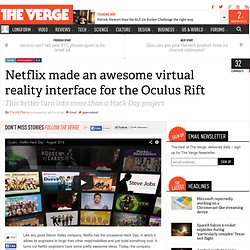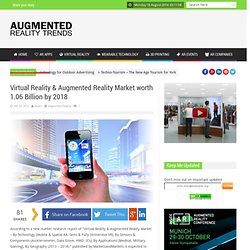

Digital Domain Expands Into Performance Hologram Sector. Bientôt des publicités 3D flottant dans l'air ? Burton, une société créée par un groupe de scientifiques japonais, travaille depuis plusieurs années sur une technologie d’affichage qui diffuse des images 3D flottant dans l’air.

Le système pourrait être testé en conditions réelles, dès l’année prochaine au Japon, par des entreprises et des municipalités. © DigInfo, Burton Inc. 10 opérations marketing utilisant l’Oculus Rift. Après la personnalisation… la personnification. Euclideon SOLIDSCAN - Capture Reality. The Future of Travel Has Arrived: Virtual-Reality Beach Vacations. These two virtual-reality Teleporters are making their debut in New York: one at the Marriott Marquis, and one near City Hall.

(Courtesy: Marriott Marquis/Framestore) By Peter Rubin I’m the only person in the hotel lounge. It’s night, and darkness lingers beyond the windows. Despite the room’s emptiness, there’s a feeling of warmth; a fireplace crackles, and music mixes with the hum of subdued conversation and clinking glasses. “Actually,” a voice says from somewhere beyond my headphones, “you might want to take a small step forward.” Netflix made an awesome virtual reality interface for the Oculus Rift. Like any good Silicon Valley company, Netflix has the occasional Hack Day, in which it allows its engineers to forgo their other responsibilities and just build something cool.

It turns out Netflix engineers have some pretty awesome ideas. Today, the company released a handful of videos of its favorite Hack Day projects, including a Chrome extension that lets you watch Netflix in a mini screen while you do something else and a way to match your movie to your room's ambient lighting with Philips Hue bulbs. Netflix did of course provide the "most or all of these projects are just fun and will never actually be a part of Netflix" disclaimer, but if it doesn't eventually make the floating, flying, gesture-based Oculix interface for the Oculus Rift, then, well, everything is ruined. This is how I want to find movies in the future. Check out Oculix in the video above — and click below for the rest of the Netflix Hack Day projects. Watch How "Electronic Makeup" Completely Transforms This Model's Face. Nvidia et l'Université de Caroline du Nord veulent révolutionner la réalité augmentée.
Meet Hao Li, 2013 Innovator Under 35. Real-Time Non-Rigid Reconstruction Using an RGB-D Camera. Les créateurs de Siri développent une intelligence artificielle 10 fois supérieure. Si Siri est connu comme l'assistant virtuel intégré à iOS dans les produits d'Apple, l'intelligence artificielle n'est pas née dans les laboratoires de la firme de Cupertino.

En 2007, une équipe de chercheurs du SRI ( Stanford Research Institute) travaille sur le projet CALO ( Cognitive Assistant that Learns and Organizes), un logiciel d'intelligence artificielle capable de comprendre les requêtes de l'utilisateur et d'organiser les données. Adam Cheyer, architecte logiciel dans le projet, cofonde alors une société baptisée Siri avec Dag Kiiilaus, Tom Gruber et Norman Winarsky.
En 2010, Steve Jobs contacte la société et Apple rachète cette dernière pour en intégrer le logiciel dans iOS 5 dès octobre 2011. Par la suite, les créateurs de Siri s'envolent vers des horizons soulagés des contraintes imposées par Apple. NBA Courtside at Home? Live Action Virtual Reality is Here and Better than Expected. William Gibson famously said, “The future is already here – it’s just not evenly distributed.”

I’m guessing Gibson was probably referring to the coming world of live action content for the Oculus Rift, and if that’s true he’s exactly right. The future is stuck in a Palo Alto office loft. JauntVR to be exact. Forget the simulated world of virtual reality video games. The real VR disruption is coming from live action. My journey began when I came across a press release describing some new type of cinematic VR platform, just recently out of stealth mode, who announced $6.8M in funding from a who’s-who in the film industry. To get a sense of what JauntVR has built, their technology is described as “an end-to-end solution for creating cinematic VR experiences.”
Rarely is the window into the future as stunningly clear as was for me for the next few minutes inside that Oculus Rift. It was the next demo, though, when my jaw finally hit floor. Augmented Reality Trends Virtual Reality & Augmented Reality Market worth 1.06 Billion by 2018. According to a new market research report of “Virtual Reality & Augmented Reality Market – By Technology (Mobile & Spatial AR, Semi & Fully Immersive VR); By Sensors & Components (Accelerometer, Data Glove, HMD, ICs); By Applications (Medical, Military, Gaming), By Geography (2013 – 2018) ” published by MarketsandMarkets is expected to grow at a CAGR of 15.18% from 2013 to 2018 and reach 1.06 billion in 2018.

The data mentioned is for dedicated augmented reality and immersive virtual reality systems only. Separate analysis for mobile based AR and non immersive VR is done. Augmented reality is a thriving technology where digital data merge with real world. This technology superimposes the real world with computer generated data which completely changes the user experience. It changes what we hear, feel and see. Khronos Group Starts Working On The Next Generation Of Its OpenGL 3D Specs. In line with its regular update cadence, the Khronos Group — the organization behind specs like OpenGL, OpenCL and WebGL — today launched updated specs for its OpenGL specs for 3D desktop applications at SIGGRAPH 2014.

There are a couple of major updates that will result in smoother 3D graphics and make the lives of developers a bit easier, especially if they want to port applications from DirectX11. More importantly, however, the non-profit consortium today announced its call for participation to define the next generation of this 3D standard. As Khronos president (and Nvidia VP of content development) Neil Trevett told me last week, this is meant to be a ground-up redesign to create a truly modern 3D API.
The Khronos Group already started work on this internally in order to set some keystones, but it is now opening up the process to the whole ecosystem. The other keystone feature will be a focus of multithreading to reduce overhead. Universities Look To Oculus Rift To Lure Students To Campus. Bientôt des Airbus sans cockpit ?